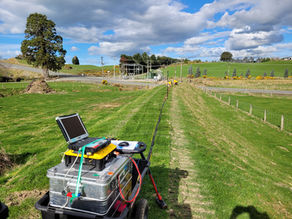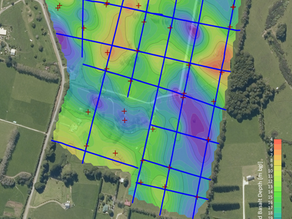top of page


Welcome to Cook Costello Insights, our hub for technical knowledge, fresh perspectives, and thought leadership on the future of engineering in New Zealand. From land development and infrastructure to sustainability and digital innovation, our team explores the challenges and opportunities shaping the industry.
Whether you’re a client, collaborator, or curious reader, we invite you to explore our latest thinking and join the conversation on building stronger, more resilient communities.


Improving Temporary Working Platform Verification Using Plate Load Testing
Temporary working platforms are essential for the safe operation of cranes, piling rigs, and heavy plant, yet they often receive limited engineering attention. Cook Costello analysed 41 Plate Load Tests across seven New Zealand sites to develop locally relevant acceptance criteria, confirming that stiffness and strength must be verified independently to achieve safer, evidence-based platform design.
3 min read


Developing Site-specific Small-strain Shear Modulus Correlations from SCPT Data
Step‑by‑step guide showing how to estimate soil density, shear modulus (G₀) and effective pressure from seismic CPT data to develop site‑specific correlations for accurate seismic site response.
2 min read


Why Geotechnical Lab Testing Matters in Construction?
The article explains why accurate soil classification, strength and compaction testing improve foundation design, reduce risk and support sustainable, cost‑effective construction.
3 min read


Lightweight Deflectometer Testing: Powerful, Portable and Precise
Shows how the lightweight deflectometer provides fast, accurate soil stiffness measurement for earthworks, roading and remote sites, with tips on standards and data interpretation.
2 min read


Designing Timber Compaction Piles using CPT
The article covers when timber compaction piles are suitable for saturated sands and how CPT‑based calculations optimise pile diameter and quantity to achieve target density and mitigate liquefaction.
2 min read


Estimating the Void Ratio of Saturated Sands from CPT
Outlines how to estimate bulk unit weight and void ratio from cone penetration tests to produce continuous void‑ratio profiles for foundation, hydraulic and seismic design.
2 min read


Real Estate and Insurability in New Zealand: Addressing a Growing Challenge
Explains how risk‑based insurance pricing and natural hazard assessments affect property transactions in NZ and why buyers and sellers need natural hazard risk reports.
2 min read


The Importance of Writing Accurate Producer Statements
The article highlights the legal importance of New Zealand PS1–PS4 producer statements and best practices for construction monitoring and documentation to avoid liability.
3 min read


Landslide Damage: Where It Happens and How to Fix It
Describes common landslide triggers in New Zealand and outlines geotechnical assessment and remediation options like retaining walls, palisades and soil nails to stabilise slopes.
2 min read


Building with Certainty: Why Geotechnical Assessments Matter
Explains how early geotechnical assessments identify hazards such as liquefaction and swelling clays, inform foundation design and save time and money on building projects.
2 min read


Soakage Testing and Soak Pit Design: Meeting New Stormwater Requirements in The Greater Wellington region
Describes site assessment and percolation tests for designing soak pits under Greater Wellington’s stormwater rules, enabling compliance, sustainability and cost certainty.
2 min read


Assessing the Structural Integrity of Stopbanks
Shows how MASW, GPR, Vs30 profiling and electrical resistivity surveys identified stratigraphic changes, hidden culverts and weak zones in stopbanks to guide maintenance.
2 min read


Detecting Unmarked Graves or Archaeological Features
Describes a 7,000 m² ground‑penetrating radar survey that found 27 potential unmarked graves, enabling planners to protect cultural heritage and adjust development plans.
2 min read


Detecting Voids in a Karstic Environment
Explains how electrical resistivity tomography and targeted drilling mapped karstic voids beneath a quarry floor, allowing safe extraction planning and hazard mitigation.
2 min read


Determining Location and Extent of Landfill
Shows how resistivity, MASW and borehole data produced a reliable ground model of landfill boundaries, depth and potential leachate paths, reducing uncertainty and cost.
2 min read


Site Classification Investigations for Subdivisions
Describes a 60 ha subdivision study using resistivity, seismic and shear‑wave profiling to map geology, groundwater and bedrock depths, informing earthworks and foundation design.
2 min read


Void Detection in Dam Spillway
Learn how advanced geophysics, when integrated with targeted invasive testing, provides dam operators with a reliable, efficient, and non-disruptive method for safeguarding critical spillway infrastructure.
2 min read


Static Plate Load Testing
Explains why static plate load tests provide direct measurement of ground stiffness for crane pads, roads and subdivisions, and lists key questions to scope your PLT.
2 min read
bottom of page
